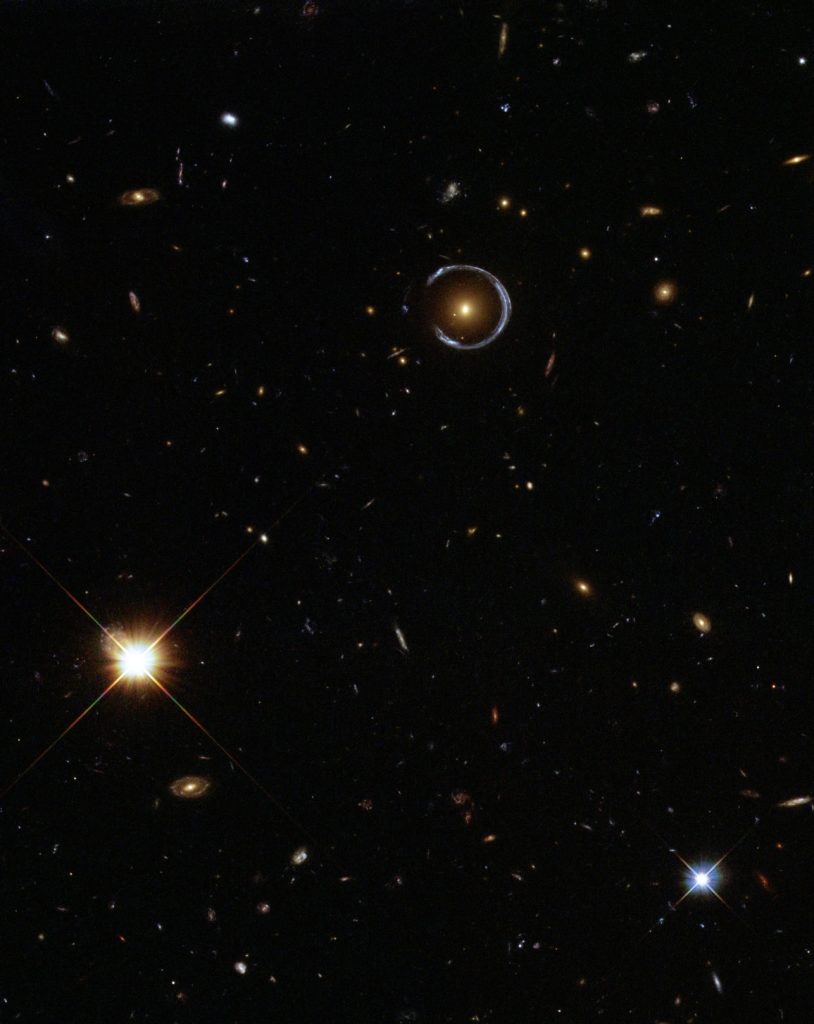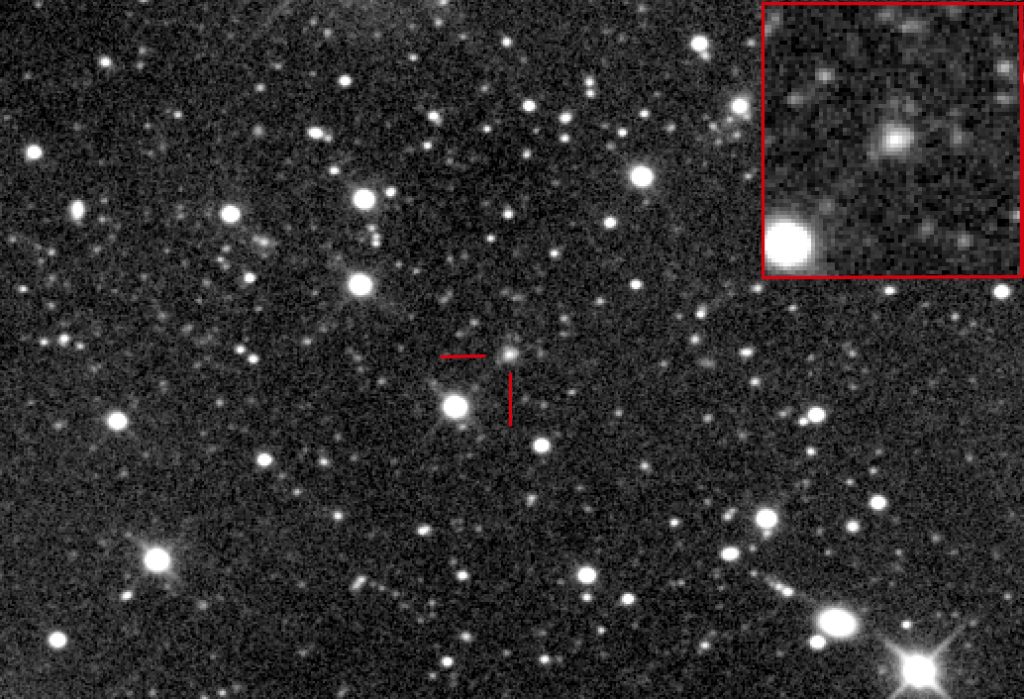2023 May 7
Cosmic Horseshoe
Deep Sky Note #4
When I read Callum’s Deep Sky Update for February, I totally missed the mention of the Cosmic Horseshoe so, it was only when observations started turning up in the BAA Gallery that I became aware of the suggestion to image it
[1]. I’ve imaged the double quasar in Ursa Major before and did try a gravitational arc (and failed) several years back, but I have not attempted any lenses in a long while.
Not that it would have mattered anyway, as the weather here in south west Wiltshire was as miserable as sin – and, whoever coined that expression, clearly lacked imagination. Here, we got lots of rain, the garden pond was overflowing and the few clear nights that did occur seemed always to synchronise with other activities.

This meant there was no chance for me to participate in the observing attempts until the shorter nights of mid-April, when Salisbury got a couple of half decent clear moonless sessions on the 17th (dark, clear, good seeing) and the 19th (dark, slightly hazy initially, seeing average). Obviously, by mid April you have to stay up later for astronomical twilight to end, but that occurred at about 21:25 which is hardly late – the 19th was a particularly nice surprise as the Met Office, MeteoBlue and BBC websites had all forecast only a brief gap in the clouds.
Anyway, after spending some twilight time looking at McNeil’s (still absent) Nebula and C/29P’s latest outburst, I settled down to look first at JUICE, which I caught at 500,000 miles range – yeah, I know its pointless, but I find it fun – and then moved on to the Cosmic Horseshoe. I arrived at it just after it had crossed the meridian and captured ~250x 30s frames – giving up only because I had dozed off in a chair and the manual dome prevents letting it capture images unattended. On the second night I again went after JUICE (now at 1,100,000miles range – again successfully) and then on to the Cosmic Horseshoe which I imaged using ~120x 60s exposures, with roughly half collected either side of the meridian. I have to say a manual dome is probably good for me, as every 30minutes I need to go out and realign it and, if things were fully automated, I would get far less exercise on a clear night
[2].
The instrument used was a 300mm f/4 Orion Optics UK Newtonian which was mounted on a 2007 era SkyWatcher NEQ6 with a Rowan band update. The camera employed was a Starlight Xpress Trius 694 with a mono sensor being run a -30C and x2 binning. I had intended to use x1 binning but forgot what the binning default setting was on the SXcon software – despite having written it. At the start of each night I also checked the telescope collimation. Best guesses for sky brightness are 17th April mag 21.0 and 19th April mag 20.8.

I have to say that even after 4 hours, its not an inspiring field of view. Nothing much in the way of bright field galaxies and only one asteroid noted plus…. the lensing galaxy.
LRG 3-757, doesn’t look much to write home about either – despite being 10x more massive than the Milky Way and being strikingly red in the Hubble image. But, realistically, what would you expect from a galaxy that is quoted as mag 20.8 at Gaia g and 18.2 in the i band – the 300mm Newt isn’t the Keck. Even so, it can be clearly seen in the image and, as someone who, in the 1980s, gawped in admiration at the emulsion based images of Ron Arbour and Jack Newton, I’m pretty content with how it came out.
Looking closely at the image it seems to me that the outer edge of the galaxy on one side is closer in to the centre of the galaxy than on the other sides. As the edge in question is where there is a gap the ring structure of the gravitational lens, I’m tentatively suggesting that I may have got it. Certainly, checking the magnitude scale Zero Point (ZP) of the image using Gaia g comparison stars suggests that magnitude 21 objects are present in the scene, so a detection is plausible. The only shame is that the platescale is 1.58 arc secs per pixel which means the lens is not resolved. However, if I had used x1 binning the image would have been a lot dimmer – I would have needed 4x the exposure to get an equivalent result and 16 hours on one object is a long time when you don’t own a remote automated observatory in Spain, Chile or Australia – what, me jealous? 🙂 . Its open to question whether I would have devoted 8 nights to the task. Certainly not this year.
I was also curious to see how the two image sets compared – the 2 hours worth of 30s exposures versus the 2 hours worth of 60 images. Now, as the images were not taken simultaneously using identical imaging systems, its hard to be truly definitive but, oddly, the 30s image stack looks the better of the two with marginally sharper stars. This might be due to slightly more blurring of the star images in the 60s images, arising from the unguided telescope or due to the slightly poorer seeing mentioned before.
Something else I looked at was the impact of one of the image stacking parameters AstroArt8 provides. It offers the option of using fractional pixel offsets ie presumably, employing interpolated values rather than using nearest neighbour values when stacking. Looking very closely at the results – pixel peeping, there is a difference between the images, but not as much as I had expected. The interpolated image looks very slightly lower contrast, but all significant features appear in both products. This did surprise me but the result may be down to the large number of images used and the plate scale – which is roughly half the normal seeing disc.
So, what have I learned?
1, a 300mm aperture, at a darkish site, can show the presence of the gravitational arc known as the Cosmic Horseshoe in just 4 hours of imagery. However, if you need the arc to be clearly resolved, then a considerably longer light collection period would be needed.
2, The exposure time needed for a detection using a 10” or 8” aperture would be significant. By contrast, 14” or larger, instruments used at a dark site will do very well.
3, I will probably always use nearest neighbour stacking when I have >50 frames.
4, I won’t worry about whether I use 30s or 60s exposures – the result is very similar.
5, Guided exposures will probably be needed to go much fainter than mag 21.
Anyway, I hope this was of some interest. Once again it looks like, when you image the deep sky, collecting an hours data should be seen as the bare minimum.
P.S. For anyone who wondering what you would get imaging it for >30hours with a 14” Planewave from a dark site in New Mexico….https://www.astrobin.com/enokjo/B/
[1] In my defence, I blame the distraction of Mike Harlow’s excellent sequence of observations of Gyulbudaghian’s nebula. It is very good. If you have not seen it, go and have a look at: https://britastro.org/wp-content/uploads/2023/03/MrG_3years_mjh1.jpg
[2] That said, if anyone knows how to easily automate an early Pulsar dome, then I’m all ears.
| The British Astronomical Association supports amateur astronomers around the UK and the rest of the world. Find out more about the BAA or join us. |
